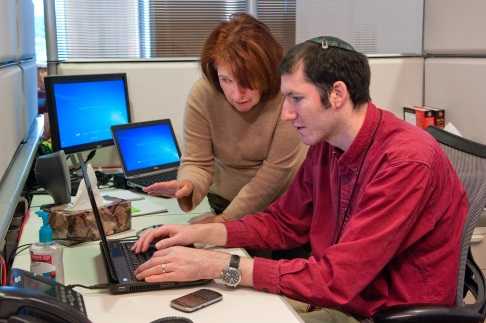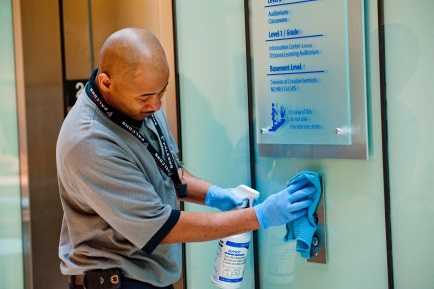Workplace Administrators
Flu Prevention at Work
Workplaces offer many opportunities for people to interact. More interaction between people in close contact increases the risk for respiratory illnesses like the flu to spread. Preventing illness among employees can also support healthy and steady workplace operations.
Getting a flu vaccine every year is the best way to avoid getting seasonal flu. Besides the flu vaccine, there are other important actions you and your community can take to protect yourself and others from getting and spreading the flu. These are called nonpharmaceutical interventions or NPIs. Examples of NPIs include staying home when you are sick and covering your coughs and sneezes. NPIs are especially important during pandemic flu outbreaks, when people have little or no immunity to a new flu virus and a vaccine is not yet available.
- What you can do personally (Personal NPIs): Stay home when you are sick. Cover your coughs and sneezes. Wash your hands often.
- What communities can do (Community NPIs): Implement social distancing interventions in schools, workplaces, and at events.
- What everyone can do to keep the environment germ-free (Environmental NPIs): Clean frequently touched surfaces and objects like door knobs.
- CDC provides educational resources and training on how to incorporate personal, community, and environmental NPIs into your pandemic flu plans.
The actions you take and the plans you make today make a difference. Here are some important steps for protecting yourself and your staff from getting and spreading the flu at work:
1. Building flu prevention into the operations and planning of your workplace.

- Work with your local health department and other partners to review or develop a pandemic flu plan for your community.
- Develop an emergency communication plan for sharing information with managers, employees, clients, and customers during a flu pandemic.
- Share the pandemic flu and emergency communication plans with managers and employees.
- Establish flexible attendance and sick leave policies for managers and employees.
- Develop a system to alert the local health department about large increases in absenteeism due to flu-like symptoms.
- Designate a separate room and transportation for sick employees, if necessary.
2. Being prepared and informed.

What to do:
- Stay informed about your local flu situation through communication with your local health department.
- Consider providing the seasonal flu vaccine when it is available in your area.
* During a flu pandemic *
- Make plans for what to do if your local public health department recommends closing schools or canceling events.
- Consider providing the pandemic flu vaccine as soon as it is available in your area.
Why is this important?
Knowing what precautions to take and where to go to get credible information will help you make plans for protecting your employees.
3. Communicating with employees about flu prevention through emails, websites, posters, and announcements.

Use staff training, routine workplace communications, and email announcements to encourage healthy workplace policies and behaviors.
Encourage managers and employees to
- Get a seasonal flu vaccination as soon as it becomes available in your area.
- Take everyday preventive actions, such as staying home when sick, staying home if exposed to someone else who is sick, covering coughs and sneezes with a tissue, and washing their hands or using hand sanitizer.
Encourage managers to
- Promote sick leave policies that encourage sick employees to stay home.
* During a flu pandemic *
Encourage managers and employees to
- Avoid gathering in other places when workplaces are closed in order to limit close contact.
- If they must gather, recommend that they limit themselves to small groups of less than 6 people and make sure groups consist of the same employees each day.
Encourage managers to
- Update employees, customers, and suppliers with information about how your workplace is responding to the pandemic.
- Use a monitoring system to track employee absences due to flu.
- Consider providing the pandemic flu vaccine as soon as it becomes available
Provide additional staff training that includes
- Cross-training employees to ensure coverage in case people need to stay home when sick.
- Separating sick people from healthy people, and sending sick people home as soon as possible.
4. Maintaining a clean environment, and providing employees with supplies that prevent the spread of flu.

- Clean frequently touched surfaces and objects, such as telephones, keyboards, and doorknobs.
- Provide supplies that promote healthy hygiene, including tissues, soap, and hand sanitizer.
Flu Prevention Tools and Resources at the Work
Educational Materials
- Get Your Workplace Ready for Pandemic Flu [PDF – 16 pages]
- Get Your Community Ready for Pandemic Influenza Using Nonpharmaceutical Interventions [PDF – 17 pages]
- Pan Flu Checklist: Workplace Administrators [PDF – 1 page]
- Don’t spread germs at work (Employers) [PDF – 1 page]
- Stay home if you’re sick (Employers) [PDF – 1 page]
- Page last reviewed: August 2, 2017
- Page last updated: August 2, 2017
- Content source:


 ShareCompartir
ShareCompartir